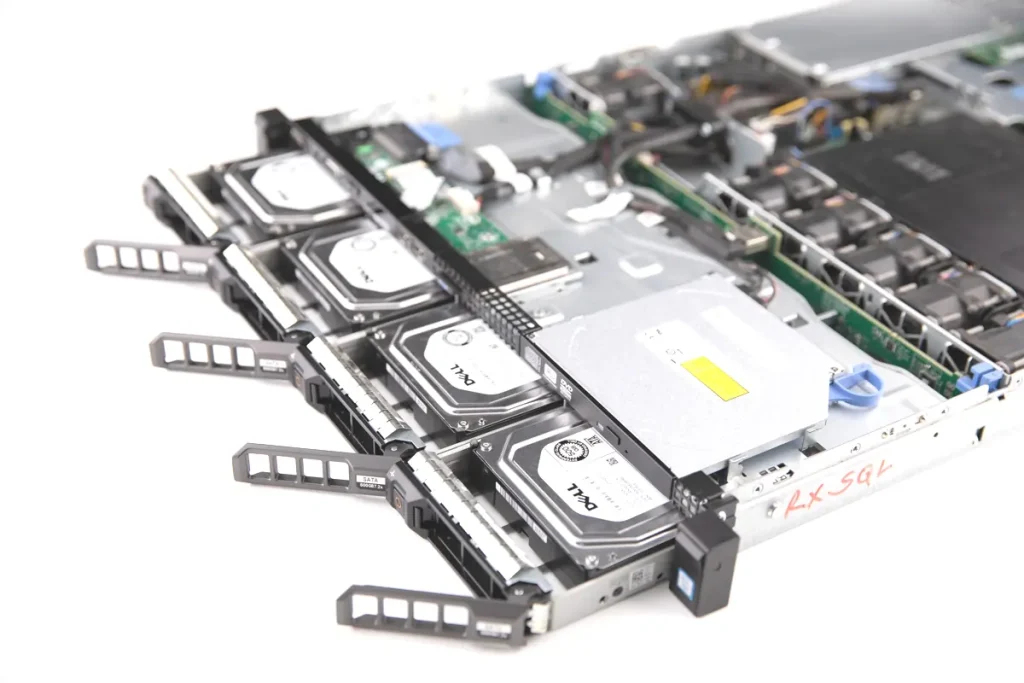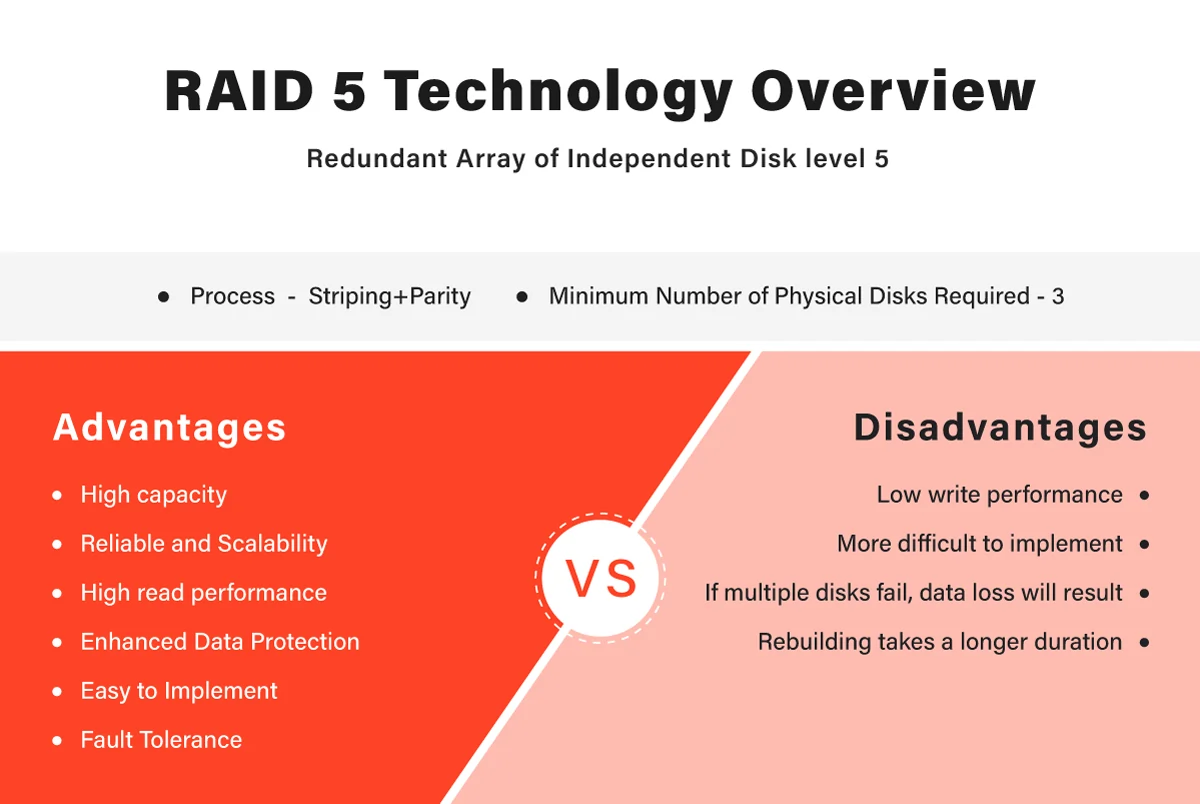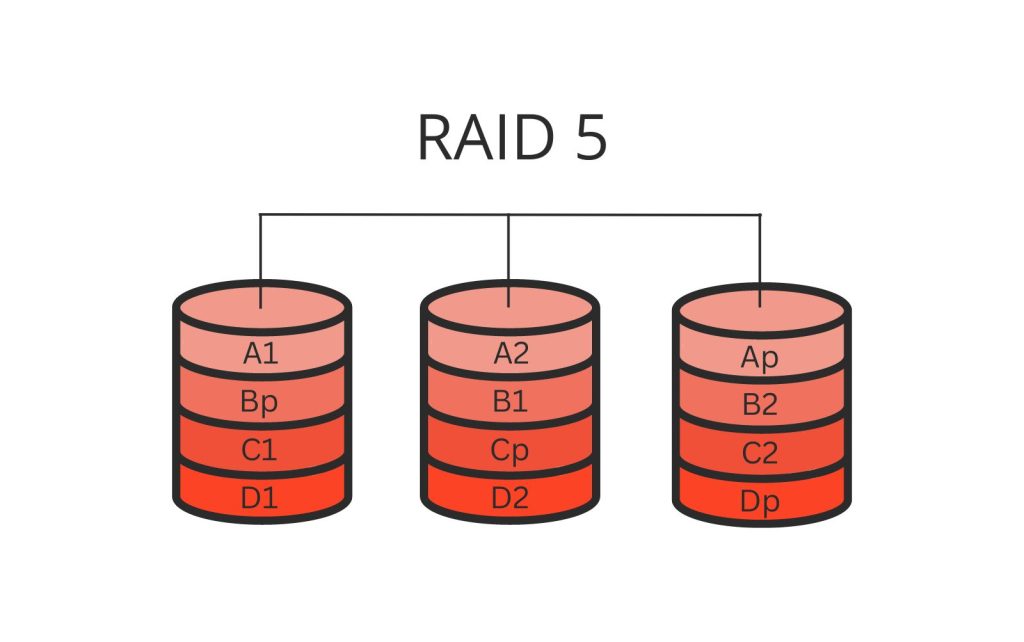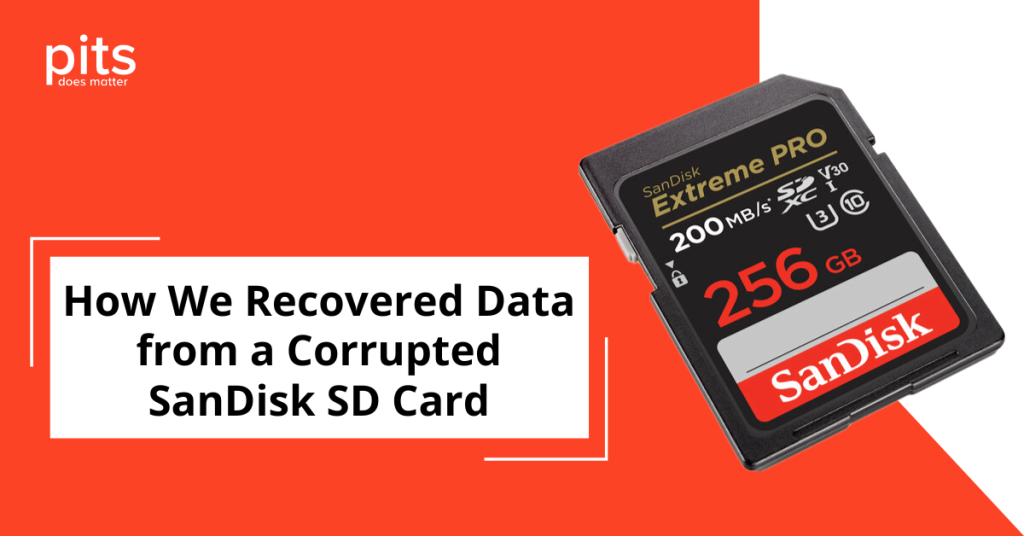RAID 5 constitutes a widely embraced data storage solution, proffering a plethora of advantages tailored to both corporate entities and individuals alike. Through the dispersion of data across a multitude of drives, RAID 5 manifests augmented operational efficiency, heightened storage capability, and fortified data safeguarding. This present discourse undertakes an incisive exploration of the prerequisites requisite for the implementation of RAID 5, concurrently delving into a comprehensive elucidation of the pivotal merits inherent in this technological paradigm.
RAID 5 Prerequisites - Determination of Drive Quantity for RAID 5
Within the realm of RAID 5, the minimal quorum of drives equates to three, notwithstanding the potential for augmenting this number to bolster capacity. These drives are characterised by uniformity in dimensions, read velocity, and origin. Whilst it remains within the realm of technical feasibility to integrate drives of divergent sizes, the prevailing counsel leans towards the utilisation of devices that match or exceed the dimensions of the smallest drive within the array. This pragmatic stance ensures the optimal exploitation of available storage expanse.
An additional pivotal aspect to contemplate during the establishment of RAID array 5 pertains to the interface type employed by your drives. Contemporary storage devices predominantly adopt either SATA or SAS interfaces. It is imperative to ensure the congruence between the interface employed by your hard disk drives and that supported by your RAID controller. Furthermore, judicious consideration must be devoted to selecting a RAID controller that aligns harmoniously with your operating system. Our web-based RAID 5 calculator empowers you to judiciously determine the optimal count of drives for your array.
Appropriate Deployments for RAID 5 Arrays
RAID 5 constitutes a versatile storage solution with applicability spanning an extensive gamut of scenarios. Among the most prevalent utilisation of RAID 5 are:

File Servers: RAID 5 emerges as an exemplary selection for file servers, where the confluence of data preservation and operational efficiency is paramount. Through the equitable distribution of data across multiple drives, RAID 5 engenders swifter data retrieval times and heightened resilience against faults.
Databases: The RAID 5 configuration seamlessly dovetails with database applications, particularly those entailing swift storage and retrieval of substantial data volumes. Employing RAID 5, databases can be judiciously distributed across an array of drives, thereby facilitating accelerated read and write velocities.
Multimedia Applications: Leveraging the dispersal of data across an array of drives, RAID 5 yields read and write speeds surpassing those of solitary drives. Such attributes render RAID 5 eminently suitable for multimedia applications, including tasks like video editing that necessitates rapid and dependable access to substantial file sizes.
Advantages of RAID 5 - Operational Mechanism of RAID 5
Enhanced Performance. Through the dispersion of data across a multitude of drives, RAID 5 can furnish expedited read and write velocities surpassing those of an individual drive. This stems from the concurrent data retrieval from multiple devices, thereby curtailing the time required for handling substantial file reads or writes.
Augmented Storage Capacity. Employing a Redundant Array of Independent Disks configuration, one can consolidate numerous drives into a singular array, thereby augmenting the storage capacity. This translates to an increased data retention capability without necessitating the procurement of supplementary drives.
Amplified Data Safeguarding. Foremost among the merits of RAID 5 lies its intrinsic capability to safeguard data against drive malfunction. In a RAID 5 setup, data undergoes distribution across multiple drives, facilitating data reconstruction using the contents stored on the operational drives in the eventuality of a single drive failure.

Resilience Against Anomalies. RAID 5 bestows resilience against anomalies, signifying that the data within operational drives remains accessible even if one drive experiences a failure. This is attributed to the division of data on each drive into discrete blocks, which are subsequently distributed across an array of disks. Ergo, in the event of a drive failure, the data can still be retrieved from the remaining unaffected drives.
Uncomplicated Implementation. The deployment of RAID 5 is characterised by simplicity, for it mandates solely a compatible RAID controller and drives of identical specifications. Once these prerequisites are satisfied, the establishment of RAID 5 ensues as a straightforward procedure well within the grasp of most users.
Scalability. An additional virtue of RAID 5 pertains to its scalability, enabling the seamless integration of supplementary drives into the array to meet evolving requirements. This furnishes businesses and individuals the facility to expand their storage potential commensurate with their burgeoning needs, devoid of necessitating the replacement of extant hardware.
Data Loss Incidents in RAID Level 5
Although RAID 5 represents a resilient and dependable data storage solution, it remains susceptible to data loss. Various prevalent factors contribute to data loss occurrences in RAID 5, including:
Multiple Drive Failures
Despite RAID 5’s capacity for fault tolerance, it can solely withstand the failure of a solitary drive. Should numerous drives falter concurrently or within a short span, it can culminate in data loss. This limitation stems from RAID 5’s stipulation of a minimum of three devices. In instances where more than one drive experiences failure, data recovery prospects are scant.
Controller Failure
The efficacy of the RAID controller resides in its management of the storage array and the facilitation of data distribution across diverse drives. Should the RAID controller malfunction, it can precipitate data loss or corruption.
Human Oversight
Human fallibility ranks among the prevailing factors engendering data loss across varied storage systems, including RAID 5. Inadvertent deletion, formatting, or data overwriting can precipitate the irrevocable loss of pivotal information.

Power Surges and Outages
Occurrences of power surges and outages can engender data loss or corruption within RAID 5 systems. This arises from abrupt power cessation, potentially impeding the proper functioning of the RAID controller, or data could be in the process of writing onto the drives when the power disruption transpires.
Force Majeure Events
Force majeure events encompassing floods, earthquakes, and fires can occasion physical harm to drives or the storage array, resulting in data loss.
Software Deterioration
Software degradation may transpire due to an array of reasons, encompassing viruses, malware, or operating system breakdowns. Such occurrences can instigate data loss or corruption within RAID 5 systems, occasionally necessitating a complete reconstruction of the storage array.
Hardware Debilitation
Hardware debilitation can emanate from an assortment of factors, including excessive heat, mechanical breakdown, or aging components. In the event of a drive or other hardware component malfunction, data loss can ensue within the RAID 5 system.
RAID 5 Data Recovery with PITS
Within the precincts of PITS Global Data Recovery Services, we extend a comprehensive array of data recovery services tailored for diverse RAID configurations, encompassing RAID 5 arrays. Our adept engineers, adeptly equipped with cutting-edge tools, stand poised to recover data from an assortment of RAID arrays, even those grappling with multifarious drive failures or intricate conundrums.
Our protocol for RAID data recovery commences with an exhaustive assessment of the impaired RAID 5 array. This meticulous scrutiny empowers us to identify the causative factors behind the data loss and strategise accordingly. Our engineers orchestrate data recovery from RAID systems through an amalgam of specialised hardware remedies and manual methodologies.
Benefits of Our RAID 5 Data Recovery Services:
24/7 Emergency Service Availability
So if you're facing a data loss situation, don't hesitate to contact us. Our 24/7 data recovery services are available 365 days a year. Let us help you recover your precious data today.
Certified Data Recovery Laboratories
So if you're facing a data loss situation, look no further. With our certified data recovery labs and 99% success rate, we are confident that we can recover your precious data and get you back on track.
Data Recovery Services Worldwide
PITS is a leading global recovery service provider specializing in retrieving data from various storage devices. With a widespread network of locations, we offer reliable solutions to clients worldwide.
ISO Certified Class 10 Cleanroom
Our engineers work in a controlled environment to ensure the safety of your device. We recover data in ISO Certified Class 10 Cleanroom and achieve high results.
Risk-free Evaluation and Assessment
We start the process with a risk-free evaluation. Our technicians estimate the reasons for data loss and the level of damage. We select the most suitable strategy.
100% Customer Satisfaction Rate
With years in the data recovery industry, our company supports the highest customer satisfaction rate. We do everything to provide a positive experience for our clients.
We are acutely cognizant of the temporal urgency integral to the data recovery process, particularly in contexts where enterprises and establishments lean heavily upon their data infrastructure. Ergo, we extend emergency RAID data recovery provisions, boasting swift turnaround durations of 8-48 hours. This expeditious approach aims to curtail downtime and expedite the restoration of our client’s operational systems.
At PITS Global Data Recovery Services, we internalise the incontrovertible fact that each data recovery predicament is endowed with a unique complexion. In light of this, our engineers endorse an individualised trajectory for every recovery endeavor, thereby optimising the prospect of a superlative outcome. The assembly at PITS is unwavering in its commitment to delivering dependable and efficacious RAID data recovery services, pivoting on the fulcrum of peerless customer service and unwavering communication throughout the recovery continuum. For enlisting our RAID 5 recovery provisions, we encourage you to initiate contact through the submission of the form provided below.
Frequently Asked Questions
What Constitutes RAID 5?
RAID 5 embodies a data storage methodology wherein diverse hard drives are amalgamated to furnish fault tolerance, heightened operational efficacy, and data preservation. It employs a parity block that facilitates the system’s capacity to reconstruct data in the eventuality of a single drive’s failure.
What Are the Advantages Inherent in the Deployment of RAID 5?
The merits attributable to the utilization of RAID 5 encompass escalated data preservation, fault tolerance, and operational efficiency. RAID 5 introduces a stratum of redundancy that safeguards data and ensures its accessibility, even in the scenario of one drive encountering failure. Furthermore, it engenders ameliorated read-and-write performance, given the equitable dissemination of data across a multitude of drives.
What Quantity of Hard Drives is Mandated for the Configuration of RAID 5?
For the establishment of RAID 5, a minimum of three hard drives is a prerequisite. However, the configuration can be extended to incorporate additional drives to enhance both storage capacity and operational performance.
What Ensues in the Event of Concurrent Failures of Multiple Drives in a RAID 5 Array?
Simultaneous failures of multiple drives within a RAID 5 array can culminate in data loss. While RAID 5 extends fault tolerance to counteract a solitary drive’s malfunction, its design isn’t tailored to withstand the ordeal of concurrent drive failures. To forestall this scenario, it is prudent to explore elevated RAID levels such as RAID 6 or RAID 10 or to implement supplementary backup and recuperation stratagems.
We’re Here to Help
Our experienced team is committed to helping you recover your critical data. No matter the situation, we work diligently to ensure the best possible outcome. Take action now and let us restore what’s important to you.
Start Recovery Process
"*" indicates required fields


